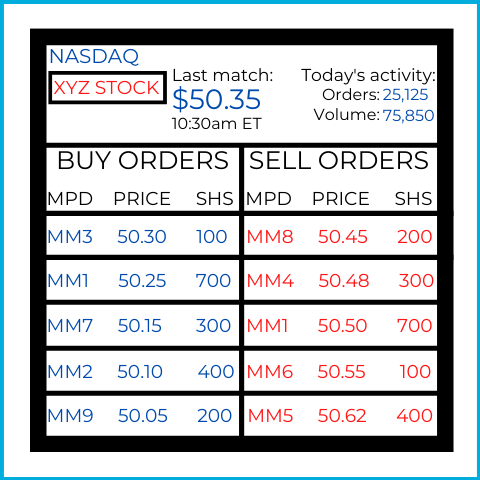Originally started in the 1970s as an association of dealers, NASDAQ grew to be one of the largest exchanges in the world. Unlike the auction market status of the NYSE, NASDAQ is considered a negotiated market. If you recall, stocks traded on the NYSE are handled by a centralized DMM; each individual stock’s trades are handled by one DMM.
NASDAQ is an over-the-counter market (no physical trading floor) of dozens of market makers trading with the public, and the ones with the best prices get the most business. If you recall from the common stock chapter, an OTC trade is one that does not take place at a physical exchange. However, NASDAQ is still considered as having “exchange status,” and all of its stocks are treated as if they’re exchange listed. Just like the NYSE, NASDAQ has high standards for stocks being listed on its platform.
Market makers must be willing to provide a continuous quote on the securities they trade, although there are several legitimate reasons for temporary or permanent withdrawal (e.g. closing the business, sick employees, unforeseen events, etc.). Regardless, market makers typically provide consistent & ongoing quotes, which look like this:
| Bid | Ask | |
|---|---|---|
| Price | $50.25 | $50.50 |
| Size | 7 | 3 |
This quote works the same way as the other bid & ask quotes we’ve discussed in this chapter. This market maker is willing to buy up to 700 shares at $50.25, while they’re willing to sell 300 shares at $50.50. This market maker has a $0.25 spread. NASDAQ is made up of dozens of market makers who display quotes like this. This is what it looks like when all market maker quotes are aggregated:

*MPD = Market maker ID
First, let’s test your knowledge. What’s the inside market?
Answer = $50.30 x $50.45 / 1 x 2
The inside market is the price and number of shares available at the highest bid (buy order) and lowest ask (sell order).
The inside market on NASDAQ is known as a level 1 quote. When investors initially pull up a quote on a NASDAQ security, they are provided with a level 1 quote that displays the best prices available in the market.
The visual above with several market maker quotes is a level 2 quote, which provides a view beyond the best prices in the market. Investors can gain access to NASDAQ’s level 2 quote system through their broker-dealers by special request. Sometimes a level 2 quote can give insight into the market. If there’s a large request to buy or sell just below the highest bid or above the lowest ask, it can influence the general direction of the market.
A level 3 quote looks the same as a level 2 quote, but it’s interactive. Participating market makers are the only ones with access to level 3 quotes. This is the system they use to place new quotes, adjust current quotes, or remove old quotes.
NASDAQ utilizes its own execution system for routing trades, which is known as the NASDAQ Market Center Execution System. Market makers using this system can enter quotes for up to 999,999 shares (just short of 1 million).
NASDAQ is open daily from 9:30am - 4:00pm ET for normal operating hours, which is the same as the NYSE. However, NASDAQ has pre-market and post-market hours, allowing investors to trade more during the day.
NASDAQ after-hours
While pre and post-market trading increase trading opportunities, there are added risks investors must be aware of. Fewer investors trade in these markets, which increases overall market volatility. Most broker-dealers require their customers to read through a risk disclosure prior to trading in the pre and post-markets. It’s important for investors to know of the larger spreads, low trading volume, and volatility occurring in these markets.
The NYSE and NASDAQ used to regulate their own markets as self-regulatory organizations (SROs). SROs are granted regulatory power and oversee the participants in their markets. In 2007, NYSE’s and NASDAQ’s regulatory arms formed into FINRA, which is the SRO that now supervises both markets. Although FINRA is not a governmental entity, it has the power to control who operates in the financial markets and how financial firms interact with the investing public.
Sign up for free to take 10 quiz questions on this topic